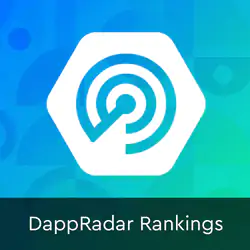Over the last six months, ‘mass adoption’ was on everyone’s lips as the blockchain space reached record numbers of dapp users. A key driving force for this surge in usage: blockchain games, and especially the play-to-earn movement. However, many events have unfolded lately that question how ready we are to go mainstream. As we enter 2022, we take a critical look.
Last year was the year everything began converging and moving even faster in (at least what we believe to be) the right direction: a multichain, cross-category state of play for the industry that, according to what our data suggested, brought us on the cusp of mass adoption. Play-to-earn games, which combine DeFi, NFTs, and gaming opportunities, coupled with the hype around anything “meta”, found traction quickly and drove a record number of users to dapps in 2021.


This state of play – multichain, cross-category, meta – is what DappRadar has always pushed for. It’s at the core of our business – instead of one category winning the battle for supremacy, we think it will be a combo of gaming, NFTs, and finance that will provide the most straightforward path to mass adoption. But let’s take off the pink goggles, and assess the good, the bad, and the ugly about what’s been happening on that multichain front lately.
Gaming: Stressful, but stress-testing
Play-to-earn games have brought more active wallets and transactions to the blockchains than ever before. Axie Infinity blossomed on Ethereum but flourished on its Ronin sidechain. In addition, Alien Worlds all but outgrew the Wax blockchain and moved operations to BSC to pursue more active users. However, some blockchains are finding their weaknesses exposed when dealing with a high number of transactions – a common characteristic of a gaming dapp. Still, blockchain gaming is providing a much-needed stress test before going mainstream.
Why do games generate so many transactions?
As most play-to-earn games revolve around the principle of completing quests and game challenges to earn tokens, many transactions are required by users — a lot more than when using a DeFi or NFT dapp, for example. Actions in DeFi may amount to 4 or 5 trades per wallet, while buying an NFT may only encounter 1 or 2. Think about how many transactions are needed in a dapp that constantly progresses players through levels, interacts with game challenges, and rewards them – a transaction is required each time.
Therefore when we talk about games on DappRadar, we often speak about unique active wallet metrics. We count on volume and sales figures when we talk about NFTs and DeFi. Hopefully, it is now clear why these metrics can be used to talk about growth in the dapp space.
Polygon, botting, and increased user costs
Polygon, the popular Ethereum sidechain, touted as the solution to the former’s gas and transaction speed troubles, had its issues brought to the fore by a single – gaming – dapp. The play-to-earn game Sunflower Farmers congested the network and drove up transaction fee costs. The game’s premise is simple: you plant seeds to grow plants, harvest and sell them to receive SFF tokens, which you can then sell or exchange. The core tokenomics work so that purchasing and planting seed costs around half what you would obtain for the crop once harvested.
Another critical factor is the presence of bots within such games. The actions required by players are very monotonous. Just a few clicks, and you are off and earning. Therefore, actions can be assigned to a bot for those who know how. Each bot will have a designated wallet. Once they connect to the dapp they are registered as one unique active wallet, and each transaction they complete is registered on the blockchain, and as a result, by DappRadar.
One user could be managing their wallet plus an army of bots. However, this is nothing new, and while highly irritating to both dapps and blockchains, it’s been happening for a while. Arguably, the problem isn’t so big for dapps as inflated user numbers lead to media mentions and positive reporting. Generally, the onus is on platforms like DappRadar to clean up and report on the metrics, which we endeavor tirelessly to do.
Until now, this hadn’t had a noticeable effect other than providing a headache for dapps, blockchains, and our data team at DappRadar. Then the high number of transactions started affecting Polygon’s gas fees, and people began taking more notice. Notably, the game was not completely dominated by bots, and there were thousands of real users there desperately competing with bots for rewards.






High demand pushes up the transaction costs
Miners process a certain amount of transactions per block. However, when there are too many transactions, users need to compete to have their actions processed by the blockchain. They need to pay more gas fees, and thus the transaction costs go up. Ironically, this is the one significant benefit of a decentralized blockchain – that spamming or trying to overrun the network costs a fee. That fee increases the more aggressively it is attacked, which is why the technology receives praise over easily attackable and centralized systems. However, in this instance, it can be a downfall when a network whose entire marketing language focuses on speed and low fees starts to charge users more for transactions.
Putting the price increase into context, fees went from around $0.00009 to approximately $0.001. So, the price hike was barely noticeable to the untrained eye. On Ethereum, users can pay anywhere between $50 to $100 for transactions. Hence, games don’t operate there, and games like Axie Infinity have now moved operations to their custom Ronin sidechain.
Although the fee increase may look marginal, users started paying attention, and, as always, when it hit them in the pocket, they voiced their concerns. Due to the rising costs, other dapps on the network were forced to delay events and initial token distributions as they did not want their users paying higher gas fees.


At the same time, the Sunflower Farmers team had another headache to deal with in the shape of a contract error that, if left exposed, could render the dapp useless. On January 7, the Sunflower Farmers team delivered a message, then shut the game down and blacklisted the SFF token. Notably, the game will be back, and players will be made whole again. This is a temporary move to try and stem the flow of bots and restore operations to normality for the benefit of both the Polygon Network and the game itself.


Moreover, it showed a few things. Firstly, Polygon can deal with a massive increase in transactions. It’s just that the cost of gas will increase when doing so – something that anyone who understands blockchains would expect. Secondly, networks need to be vigilant with play-to-earn game developers and ensure they are doing everything in their power before launch to stem the entry of bots. When bot activity starts to have a knock-on effect on other dapps on the network, it becomes a problem for everybody.
Solana falls over
The Solana blockchain also touted as a competitor to Ethereum, suffered three outages in months. It’s unclear whether the issue was a simple network failure because of high traffic or whether the network collapsed because of a DDoS attack by hackers. The Solana Foundation has confirmed none of these yet, though it can’t deny that the network witnessed a slowdown since it can be tracked in real-time. However, as one spectator here at DappRadar pointed out, even when under attack, Solana could process more transactions per second than Ethereum.
Solana had been flying high before these incidents, which left many questions about how a blockchain could be DDoS-attacked and why this occurred so many times in such a short space of time. The price of SOL took a tumble in line with the negative press, falling 21% in the last 30 days. Moreover, it gave impetus to other EVM-compatible chains such as Avalanche and Fantom to take their moment to strike.


Ethereum sitting pretty
Ethereum sits in a privileged position. It has the benefits of a first-mover advantage and broad awareness, plus it has become home to whale traders utilizing some of the first dapps ever built. These investors are happy to pay the fees for a piece of mind; it appears – a $50 on a $100,000 trade is peanuts. But not when you want to move a few hundred bucks.
As a result of gas fees on Ethereum being so high, the network is not a friendly place for play-to-earn games or frivolous traders. Its dapps attract a more serious caliber of users and those willing to pay a one-off gas fee to mint NFTs. Gas prices are currently peaking once again as several NFT collections arrive on Ethereum every week, guzzling gas and processing transactions.
However, it’s also always been clear that Ethereum alone couldn’t sustain mass adoption levels of transactions and therefore needs the help of Layer 1 and 2 solutions to take some of the burdens of the network. Hence the rise of platforms like BSC, Polygon, and Solana. If these platforms can effectively deal with what Ethereum cannot, the synergy becomes absolute, and the narrative can change from ‘Ethereum killers’ to ‘Ethereum assistants’.
Together as one
We’re not pointing fingers at any dapp, dapp category, or chain here, because they each contribute to the evolution of blockchain technology, pushing for greater adoption.
As a collective, blockchain networks can extend the required amount of computational power and transactional cost to users without boring them with the details of how it all works in the background. We, at DappRadar, see a future where the network a dapp runs on won’t matter, as long as it works intuitively for the user and can do what it says.
Still, stress- testing is essential to successful evolution, and thus far, most blockchains haven’t come under such heavy fire as inflicted by play-to-earn games. Pushing blockchains to their limits will ensure that they will be ready to deal with the demand when called upon. It’s also a way to separate the professionals from the amateurs as we head into what will surely be a year of multichain launches and exploration.
Mass adoption is an achievable destination – but the precise twists and turns along that road are unclear.
A multichain paradigm, where multiple blockchains and their dapps find success in harmony, is what DappRadar believes in, and is baked into the very core of our RADAR token. As a multichain platform ourselves, we want users to gain exposure to as many opportunities as possible, without any access restrictions or gatekeeping dapps.
 Media
Media